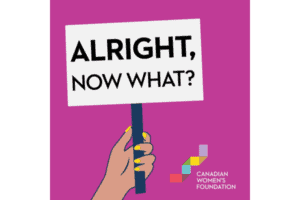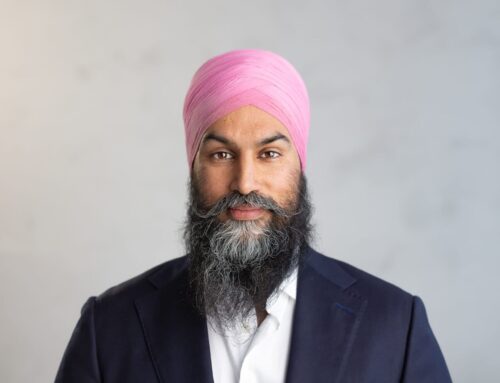 We’ve seen breaking news about the rise of alt-right ideology and its connections with misogyny, racism, homophobia, and other forms of discrimination and oppression. It’s not new, but in the COVID-19 pandemic context, it’s resurging in contemporary ways. How does this ideology stand at odds with the goal of gender justice and what do we need to do to address it?
We’ve seen breaking news about the rise of alt-right ideology and its connections with misogyny, racism, homophobia, and other forms of discrimination and oppression. It’s not new, but in the COVID-19 pandemic context, it’s resurging in contemporary ways. How does this ideology stand at odds with the goal of gender justice and what do we need to do to address it?
Luna KC joins us on these important issues. Along with her coauthors at the Canadian Research Institute for the Advancement of Women (CRIAW-ICREF), Luna wrote “The Rise of the Alt-Right in Canada: A Feminist Analysis”. She also did research on women and COVID-19 in Canada. Luna is now a Postdoctoral Researcher at the Research Network on Women, Peace, and Security at McGill University. Her work focuses on these very issues and sits at the nexus of women and warfare, gender justice, peace activism, and intersectionality.
Transcript
00:00:00 Andrea
Hi, I’m Andrea.
We’ve seen breaking news about the rise of alt-right ideology and its connections with misogyny, racism, homophobia and other forms of discrimination and oppression. It’s not new, but in the COVID-19 pandemic context, it’s resurging in contemporary ways. How does this ideology stand at odds with the goal of gender justice and what do we need to do to address it?
Welcome to Alright, Now What?, a podcast of the Canadian Women’s Foundation. We put an intersectional feminist lens on stories that make you wonder “Why is this still happening?” We explore systemic roots and strategies for change that will move us closer to the goal of gender justice.
The work of the Canadian Women’s Foundation and our partners takes place on traditional First Nations, Métis, and Inuit territories. We are grateful for the opportunity to meet and work on this land. However, we recognize that land acknowledgements are not enough. We need to pursue truth, reconciliation, decolonization, and allyship in an ongoing effort to make right with all our relations.
00:01:06 Andrea
Luna KC joins us to speak to these important issues. Along with her co-authors at the Canadian Research Institute for the Advancement of Women, Luna wrote “The Rise of the Alt-Right in Canada: A Feminist Analysis”. She also did research on women and COVID-19 in Canada.
Today, Luna is a postdoctoral researcher at the Research Network on Women, Peace and Security at McGill University. Luna’s work focuses on these very issues and sits at the nexus of women and warfare, gender justice, peace activism, and intersectionality.
00:01:39 Luna
Alt-right is an extremist ideology and movement. At its core, it is white supremacist and hateful ideology and attempts to mainstream white supremacy, sexism and other forms of hate. It’s a movement consists of different strands and subcategories and includes above ground organisations, as well as underground networks, online publications, loose ad hoc groups and coalitions. And the term alt-right was first coined in 2010. This refers to people, on the right, who distinguished themselves from traditional conservatives by opposing among others such as multiculturalism and open immigration. And I think here it is crucial to note that racism and misogyny are not new in Canada and have very deep roots.
For example, extremely high rates of missing and murdered indigenous women and girls, the residential school system, the Chinese head tax 1885, the continuous journey regulation 1908. All of this clearly shows that our colonial foundation as a white settler state is built upon the genocide, dehumanization, and oppression of indigenous peoples, Black people and discrimination against Jewish people and immigrants.
And what we see is that the alt-right’s activities and ideologies are often grounded on nationalistic slogans around freedom, unity, grievances such as employment and the economy. And they try to grow their membership by appealing to those who feel disenfranchised and the insidious nature of alt-right movements, coupled with the mainstream of many aspects of the ideology, can make it hard for the public to identify. By mainstream we mean that the alt-right’s messages of hate are even normalized in a right wing, political campaigns at the federal and provincial level. Although they seek to distinguish it from traditional conservatives, I think the alt-right is not about some individuals, it’s an ideology that shapes the structures of our society, such as the government, schools, colleges, universities, the justice system, the police system, the immigration, the labor market, and so on.
So here it is vital to note that alt-right ideology exists in both insidious and overt ways, which is why boundaries are becoming less clear defining what alt-right is.
00:04:25 Andrea
You and your co-authors speak to how alt-right ideology and activity is at odds with the goals of gender justice and you speak to why we need to be concerned about it.
Tell us more about that.
00:04:35 Luna
The alt-right movement draws upon the foundation of violent misogyny, masculinity, whiteness and patriarchical norms. We know that alt-right’s ideology spans multiple issues. Experts have come up with many sub-classifications of it. But what I think is here is that the central feature is power, maintaining power and white male domination.
And also there is a growing numbers of research showing that alt-right activities are fueled by anti- sexual and reproductive rights for women, anti-Muslim, anti-immigration, anti-Jewish, anti-Asian, anti-feminist, hatred for indigenous people and other racialized groups. So here our goal of gender equality and social justice at large aims to dismantle power and systems of domination while alt-right ideologies seek to maintain it, enforce it and strengthen its grip on power.
Many feminists have already informed us about interconnections between multiple systems of operation and discrimination. bell hooks, for example, such as we cannot end misogyny unless we eradicate the white supremacist capitalist patriarchy. And this is so true because the alt-right ideology evolves around the broad range of this in turn connected system of hidden operations such homophobia, anti-Semitism, genderism, misogyny, sexism, racism, and because of all these intersections, racialized women, LGBTQ+ people, indigenous women, Jewish women, Black women are at disproportionate risk from such a racist misogynistic movement.
And I think it is also important to acknowledge that there are also non-feminist women who support and uphold this ideology and its agenda because some women can gain influence and power by upholding a dominant power structure.
Over the past 50 years, important yet incomplete gains have been made on human rights, women rights, anti-racism, LGBTQ+ rights and indigenous people rights to name few. The alt-right points to the progress of on human rights, equality, diversity and inclusion as a damaging to white men’s identity, traditional values and they deploy fear and violence to counter it.
For example, we have seen over the past numbers of year many such racist and sexist attacks driven by alt-right ideology through the harassment and targeting different groups, including women online. What is concerning about the alt-right is the mainstreaming and mass mobilizing and now more visible and better connected than we have seen in previous decades and I think if this mainstreaming continues, many of our gains will be derailed.
00:07:32 Andrea
As individuals, as communities, as organisations, as a society, if we’re committed to gender justice, and we’re concerned about what’s happening, what actions do we need to have?
00:07:42 Luna
It is important that we think about this movement as something that is festering and has been festering. It comes from a long history. We know there is racism and sexism in this country. This is why we do our work as a feminist. What is key here is we need to join with others in civil society to have multiple deliberate actions to counter this. So in our report we write about few actions and there are two which are interconnected actions we think are most important and we can do as a feminist.
First one is strengthen our feminist movement.
Here what we mean is that we must develop concrete action plans to fight racism, sexism and misogyny using intersectional feminist approaches in all our initiatives and organizing. Focus must be on bringing meaningful progressive change that can provide a foundation to confront the growing threat of the alt- right. And also movement building has to be an active and deliberate part of our everyday work as activists and advocates in our organizations, unions, schools, faith groups and workplaces. Through building progressive movement is necessary to counter the goals and mobilization of alt-right extremism.
And the next important action is change the public discourse.
What I mean here is that to advocate for investment in public services and infrastructures. We know that there is a growing sense by many that are being left behind and disparities in wealth continue to widen.
Examples like the yellow vest shows us that economic concern can be the entry point in which the alt- right organizes. And I think here the state has a role to play in ensuring people are not disadvantaged and can meaningfully contribute and be supported by ensuring there are strong safety nets and public services like health, social assistance, childcare, housing and employment insurances for them.
If we take these two main actions, then we can combat the rise of this alt-right today.
00:09:55 Andrea
Alright now, what? Learn more about the issues, “The Rise of the Alt-Right in Canada: A Feminist Analysis” is available on the website for the Canadian Research Institute for the Advancement of Women.
What strikes me is that this is not new, it’s shrouded in contemporary language, but it very much reiterates the same longstanding oppressive ideologies. Things, like Confederate flags, Nazi symbols, and sexist and racist language, gives us a strong clue about that.
And let’s take what we heard to heart, support feminists and gender justice movements in all their diversities. There are community organizations and groups and programs to support, as well as content creators and thought leaders. When intersectional feminist voices, activism, and services are strong, the benefits are multifaceted. They have reverberating impacts that counteract divisive thinking and politics.
Please listen, subscribe, rate and review this podcast and share it with others. If you appreciate this content, if you want to get in on the efforts to build a gender equal Canada, please donate today and consider becoming a monthly donor. And thank you for being tireless in your support for gender justice.






